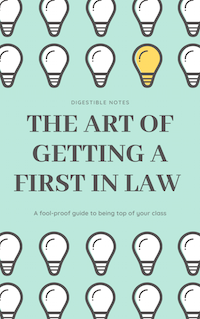Loss of Control
Definition of Loss of Control
⇒ Loss of control is a defence only to murder, and if successful the defendant will still be guilty of manslaughter.
⇒ The defendant must show (s.54 of the Coroners and Justice Act 2009):
- (1) He or she had lost self-control as a result of a ‘qualifying trigger’; AND
- (2) A person of the defendant’s age and sex with a normal degree of tolerance and self-restraint would have reacted in the same way .
⇒ In other offences (e.g. assault) loss of control does NOT provide a defence (R v Hussain and Hussain [2010]).
(1) The defendant lost self-control as a result of a ‘qualifying trigger’
⇒ Whether the defendant lost self-control as a result of a qualifying trigger is a subjective question: the jury need to look into the defendant's own mind and not at whether the reasonable person would lose self-control.
⇒ There are three elements that will be explored below:
- The defendant must lose their self-control;
- The defendant must lose their self-control as a result of a qualifying trigger;
- The definition of a qualifying trigger.
The defendant must lose their self-control
⇒ If evidence shows that the attack had been pre-planned then it is unlikely the defendant will be able to rely on this defence (R v Serrano 2006).
⇒ s.54(4) of the Coroners and Justice Act 2009 says you cannot use the defence of loss of control if the act was an act of revenge.
The Art of Getting a First in Law - ONLY £4.99
FOOL-PROOF methods of obtaining top grades
SECRETS your professors won't tell you and your peers don't know
INSIDER TIPS and tricks so you can spend less time studying and land the perfect job
We work really hard to provide you with incredible law notes for free...
The proceeds of this eBook helps us to run the site and keep the service FREE!

The defendant must lose their self-control as a result of a qualifying trigger
⇒ It is not enough for the defendant just to show he/she lost their self-control. He/She must show they were provoked by a qualifying trigger. See, for example, the cases of R v Ascott [1997] and R v Inglis [2010].
⇒ Under the old law, the loss of self-control had to be 'sudden and temporary'. This is no longer a requirement: s.54(2) of the Coroners and Justice Act 2009 states that there is no need for loss of control to be sudden. However, the longer it is since the 'qualifying trigger' the less likely the jury will accept the defence of loss of control.
The definition of a 'qualifying trigger'
⇒ Section 55 of the Coroners and Justice Act 2009 defines a 'qualifying trigger'. To be a qualifying trigger, the thing said or done must fall within one of the three categories in s.55:
- (1) The defendant must fear serious violence;
- (2) There must have been an act which was seriously provocative; OR
- (3) There must be a combination of a fear of serious violence and an extremely provocative act (i.e. both the above together).
⇒ (1) Fear of serious violence as a qualifying trigger:
- There only needs to be a fear of violence; there is no need to show there was actually violence. However, if the defendant incorrectly believed that serious violence would be used the qualifying trigger can still exist.
- The fear must be of serious violence e.g. fear of a paper cut is not enough.
- Threat to a another person also counts as a qualifying trigger in some circumstances e.g. threat to cause serious violence to the defendant's child.
- If A threatens B, you can only say there has been a qualifying trigger if B then kills A and not anybody else (e.g. C).
- There must be a loss of self-control.
- In a lot of 'loss of control' cases, a defence of self defence can be raised. Self-defence is a complete defence to murder!
⇒ (2) An act which was seriously provocative:
- The defendant must be in a situation of an "extremely grave character". It is hard to say what this exactly means, but it is usually interpreted to mean that the circumstances facing the defendant were "unusual".
- The defendant must justifiably believe to be seriously wronged. An objective test is used by the jury i.e. would the reasonable person in the defendant's position think they had been seriously wronged.
- The serious wrong must be to the the defendant e.g. insults to a friend do not count.
- s.55(6)(c) of the Coroners and Justice Act 2009 states that sexual jealousy/infidelity does not count as a qualifying trigger. For example, killing your partner because they had sex with someone else could not amount to a qualifying trigger for the purposes of the defence of loss of control.
⇒ Also see the cases of R v Clinton [2012] and R v Dawes, Hatter and Bowyer [2013].
(2) Would a person with normal tolerance and self-restraint have acted as the defendant did?
⇒ Not only must there be a loss of control due to a qualifying trigger, it must be proved that a "person of the defendant's sex and age, with a normal degree of tolerance and self-restraint and in the circumstances of the defendant, might have reacted in the same or in a similar way to the defendant” (an objective test).
⇒ ”Normal degree of tolerance and self-restraint”:
- The defendant is compared to that of the reasonable person. So if the defendant is seen to have lower levels of tolerance/self-restraint compared to the average man (even because of mental illness) it does not matter; his/her actions will still be compared to that of the average person.
- Such a defendant (i.e. a defendant with unusually low levels of tolerance/self-constraint) will struggle to succeed with this defence, but may succeed with the defence of diminished responsibility.
⇒ ”In the circumstances of the defendant”:
- s.54(1)(c) of the Coroners and Justice Act 2009 states that the jury must look at the the defendant's circumstances/situation.
- For example, calling the defendant a 'whore' may seem fairly minor but, in light of the defendant's history/circumstances, may be a grave wrong against the defendant (e.g. if the defendant has a history of being repeatedly sexually abused).
- Occasionally the court have seen a series of minor ‘cumulative provocations’ which has caused the defendant to lose self control; thus a defendant may rely on loss of control where they have lost control (i.e. they simply can take no more) following a series of minor wrongs against them.
⇒ ”Age and sex”:
- This questions whether a person of the same age/sex of the defendant would have reacted in the same way.
- It seems like a fair requirement to take into account the age of the defendant, but it’s less obvious why the sex of the defendant is a requirement to take into account → it appears to imply men and women have different degrees of self-restraint and tolerance.
Loss of control and victims of domestic violence
⇒ One matter that has greatly troubled the courts in the old law of provocation were cases where a victim of domestic violence had killed their abusive spouses.
⇒ See the case of R v Ahluwalia [1992] to see how such cases were dealt with under the old law.
- Under the new law although Mrs Ahluwalia would probably be able to show there was a qualifying trigger, she may find it harder to prove her loss of self control was due to that qualifying trigger.
- The jury would also need to determine whether someone of Mrs Ahluwalia’s age and sex would have done the same thing.
Law Application Masterclass - ONLY £9.99
Learn how to effortlessly land vacation schemes, training contracts, and pupillages by making your law applications awesome. This eBook is constructed by lawyers and recruiters from the world's leading law firms and barristers' chambers.
✅ 60+ page eBook
✅ Research Methods, Success Secrets, Tips, Tricks, and more!
✅ Help keep Digestible Notes FREE

